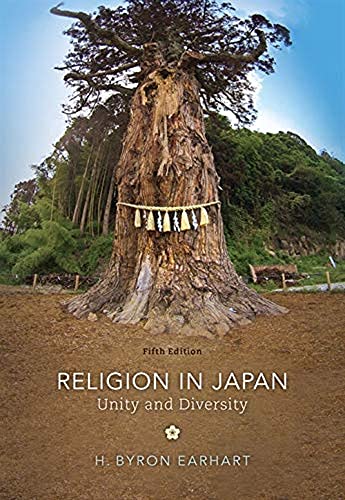Críticas:
Preface. Table of Japanese Religious History. Map of Japan. 1. INTRODUCTION. Five Religious Strands. Unity and Diversity. 2. PERSISTENT THEMES IN JAPANESE RELIGIOUS HISTORY. The Closeness of Human Beings, Gods, and Nature. The Religious Character of the Family. The Significance of Purification, Specific Rituals, and Amulets. The Prominence of Local Festivals and Individual Cults. The Pervasiveness of Religion in Everyday Life. The Intimate Bond Between Religion and the Nation. The Traditional Worldview. Part I: THE FORMATION OF RELIGION IN JAPAN. 3. THE PREHISTORIC HERITAGE. The Beginnings of Japanese Culture. The Evidence and Meaning of the Earliest Religion in Japan. The Religious Significance of Burial and the Dead. The Religious Significance of Fertility. The Religious Significance of Divine Descent. 4. BEFORE SHINTO. Mythological Materials and the Background of Shinto. Serving the Kami: Priests and Rituals in Shrines. Distinctive Characteristics of Shinto. 5. EARLY JAPANESE BUDDHISM: INDIAN INFLUENCE WITH CHINESE COLORATION. The Introduction of Buddhism as a Foreign Religion. Buddhism's Impact on the Court and the State. Buddhism and the State. The Six Philosophical Schools of Nara Buddhism. The Sanron School. Nara Buddhism. 6. CONFUCIANISM AND TAOISM: CHINESE IMPORTATIONS. Confucianism: Explicit Chinese Influence on State and Society. Taoism: Implicit Chinese Influence on Beliefs and Rituals. Confucianism and Taoism as Japanese Traditions. 7. FOLK RELIGION: RELIGIOSITY OUTSIDE ORGANIZED RELIGION. Aspects of Folk Religion in Japan. Folk Religion in Family, Village, and Occupation. The Individual and Folk Religion. 8. INTERACTION IN THE FORMATION OF THE JAPANESE RELIGIOUS TRADITION. The Interaction of Religions. The Formation of a Distinctive Japanese Religious Heritage. Part II: THE DEVELOPMENT AND ELABORATION OF JAPANESE RELIGIONS. 9. THE DEVELOPMENT OF A JAPANESE BUDDHISM: SHINGON AND TENDAI. The New Buddhism of the Heian Period. Shingon: Esoteric Buddhism in Japan. Tendai: "The Lotus Sutra," Proper Ordination for Monks, and Buddahood for All Humans. The Development of Japanese Buddhism and Japanese Religiosity. 10. ELABORATION WITHIN JAPANESE BUDDHISM: PURE LAND, NICHIREN, AND ZEN BUDDHISM. Buddhism: From Heian to Kamakura Times. The Pure Land Sects: Faith in Amida and the Recitation of the Nembutsu. Nichiren: Faith in the "Lotus Sutra" as the Exclusive National Buddhism. The Zen Sects: Enlightenment Through Meditation. Dogen: Sitting in Meditation. Zen: Institutional and Artistic Developments. 11. THE DEVELOPMENT OF MEDIEVAL SHINTO. Medieval Buddhism and Medieval Shinto. The Relation of Tendai and Shingon to Medieval Shinto. Medieval Shinto: Individual Scholars and Family Traditions. 12. THE APPEARANCE OF CHRISTIANITY IN JAPAN. The Introduction of Christianity into Japan. The Japanese Acceptance of Christianity. The Expulsion of Christianity. The Significance of the Christian Century. 13. THE FIVE TRADITIONS: DEVELOPMENT AND MUTUAL INFLUENCE. Part III: CONTINUITY AND DISCONTINUITY IN THE JAPANESE RELIGIOUS TRADITION. 14. BUDDHISM, NEO-CONFUCIANISM, AND RESTORATION SHINTO IN THE TOKUGAWA PERIOD. The Tokugawa Government and Religion. Tokugawa Buddhism: State Patronage and Weakened Vitality. Neo-Confucianism: Political Stability and Social Conformity. Neo-Confucianism: The Development of Public and Private Ethics. Restoration Shinto: The Movement for a Purified Shinto. Motoori Norinaga and Restoration Shinto. 15. THE MEIJI RESTORATION AND STATE SHINTO. The Political and Religious Significance of the Meiji Restoration. The Attempt to Restore Shinto as the Only Japanese Religion. The Establishment of Nonreligious Shrine Shinto. Japan as a Nation-State: Nationalism in World Perspective. Shrine Shinto as an Expression of Nationalism and Militarism. 16. RELIGIOUS CURRENTS FROM 1868 TO 1945. Buddhism: The Quest for Renewal. Christianity: Strength and Weakness Since 1868. The New Religions: New Variations on Old Traditions. The Fortunes of Religion 1868-1945: From Freedom of Religion to State Orthodoxy. 17. TWO NEW RELIGIONS: TENRIKYO AND SOKA GAKKAI. The Many New Religions: Differences and Similarities. Tenrikyo: A Living Kami and a Joyous Life. Soka Gakkai: Faith in the Lotus Sutra and a Happy Life. The Significance of the New Religions: Old Wine in New Bottles. 18. RELIGION IN POSTWAR JAPAN. Shinto: Disestablishment and Popular Disfavor. Buddhism: The Continuing Quest for Renewal. Christianity: The Problems of Denominationalism. The Postwar Boom of New Religions. 19. RELIGIOUS LIFE IN CONTEMPORARY JAPAN. Are the Japanese Religious? Persistent Themes in Contemporary Japanese Religion. Approaches to Religious Change. Transformations of Religious Life in Contemporary Japan. Modalities of Alternative Reality in Contemporary Japan. 20. CONCLUSION: THE CHALLENGE FOR RELIGION IN JAPAN. Study Questions. Annotated Bibliography on Japanese Religion. Index.
Reseña del editor:
This standard text explores religion in Japan as a complex tapestry of different religious strands, reflecting both the unity and diversity of Japanese culture, a theme Earhart pioneered in the first edition (1969) of this enduring, classic book--a theme he has devoted subsequent decades to refining through cutting-edge scholarship and keen observation of the evolving religious scene. Tracing the development of religious traditions from the prehistoric era through modern times, Earhart explores the vital influence of Shinto, Buddhism, Daoism, Confucianism, and folk religion. Presuming no technical or academic background, the text guides students to key Japanese religious themes, which include the proximity of humans and gods, the religious character of the family, the bond between religion and the nation, and the pervasiveness of religion in everyday life. This new edition updates the description and interpretation of the entire history of religion in Japan in light of the latest developments in the field. In the latter chapters, changes in the contemporary scene are highlighted, discussing Tokyo Disneyland, manga, and anime as "alternative reality," as well as the innovations in more "traditional" events such as wedding ceremonies and rites for the dead.
„Über diesen Titel“ kann sich auf eine andere Ausgabe dieses Titels beziehen.


